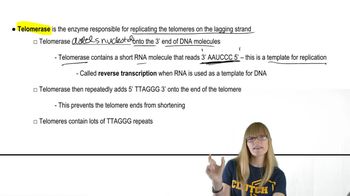Lagging strand telomeres are replicated in the same way as the rest of the chromosome
Table of contents
- 1. Introduction to Genetics51m
- 2. Mendel's Laws of Inheritance3h 37m
- 3. Extensions to Mendelian Inheritance2h 41m
- 4. Genetic Mapping and Linkage2h 28m
- 5. Genetics of Bacteria and Viruses1h 21m
- 6. Chromosomal Variation1h 48m
- 7. DNA and Chromosome Structure56m
- 8. DNA Replication1h 10m
- 9. Mitosis and Meiosis1h 34m
- 10. Transcription1h 0m
- 11. Translation58m
- 12. Gene Regulation in Prokaryotes1h 19m
- 13. Gene Regulation in Eukaryotes44m
- 14. Genetic Control of Development44m
- 15. Genomes and Genomics1h 50m
- 16. Transposable Elements47m
- 17. Mutation, Repair, and Recombination1h 6m
- 18. Molecular Genetic Tools19m
- 19. Cancer Genetics29m
- 20. Quantitative Genetics1h 26m
- 21. Population Genetics50m
- 22. Evolutionary Genetics29m
8. DNA Replication
Telomeres and Telomerase
Problem 11b
Textbook Question
There is a problem completing the replication of linear chromosomes at their ends. What is the function of telomerase, and how does it operate to synthesize telomeres?
 Verified step by step guidance
Verified step by step guidance1
Understand the problem: Linear chromosomes face an issue during replication because DNA polymerase cannot fully replicate the ends of the lagging strand, leading to progressive shortening of chromosomes with each cell division. This is known as the 'end-replication problem.'
Learn the role of telomerase: Telomerase is an enzyme that solves the end-replication problem by adding repetitive nucleotide sequences (telomeres) to the ends of linear chromosomes, preventing their shortening and maintaining genomic stability.
Explore the structure of telomerase: Telomerase is a ribonucleoprotein complex composed of a protein component (telomerase reverse transcriptase, TERT) and an RNA component (TERC). The RNA component serves as a template for synthesizing telomeric DNA.
Understand the mechanism of telomerase action: Telomerase binds to the overhanging single-stranded DNA at the end of the chromosome. Using its RNA template, it synthesizes complementary DNA sequences through reverse transcription, extending the telomere region.
Learn the significance of telomerase activity: Telomerase is highly active in germ cells, stem cells, and certain cancer cells, ensuring their ability to divide indefinitely. In most somatic cells, telomerase activity is low or absent, leading to gradual telomere shortening and cellular aging.
 Verified video answer for a similar problem:
Verified video answer for a similar problem:This video solution was recommended by our tutors as helpful for the problem above
Video duration:
2mPlay a video:
Was this helpful?
Key Concepts
Here are the essential concepts you must grasp in order to answer the question correctly.
Telomeres
Telomeres are repetitive nucleotide sequences located at the ends of linear chromosomes. They protect the chromosome from deterioration or fusion with neighboring chromosomes, which is crucial for maintaining genomic stability. Each time a cell divides, telomeres shorten, and when they become too short, the cell can no longer divide, leading to cellular aging.
Recommended video:
Guided course

Telomeres and Telomerase
Telomerase
Telomerase is an enzyme that adds nucleotide sequences to the ends of telomeres, counteracting the shortening that occurs during DNA replication. It is composed of a protein component and an RNA template that guides the addition of telomeric repeats. Telomerase is particularly active in stem cells and cancer cells, allowing them to maintain telomere length and continue dividing.
Recommended video:
Guided course

Telomeres and Telomerase
Mechanism of Telomerase Action
Telomerase operates by binding to the 3' end of a telomere and extending it using its RNA template. This process involves reverse transcription, where the RNA sequence is used to synthesize DNA. By elongating the telomeres, telomerase helps prevent the loss of essential genetic information during cell division, thus playing a critical role in cellular longevity and proliferation.
Recommended video:
Guided course

Telomeres and Telomerase

 8:38m
8:38mWatch next
Master Telomeres and Telomerase with a bite sized video explanation from Kylia
Start learningRelated Videos
Related Practice
Multiple Choice
631
views
3
rank
